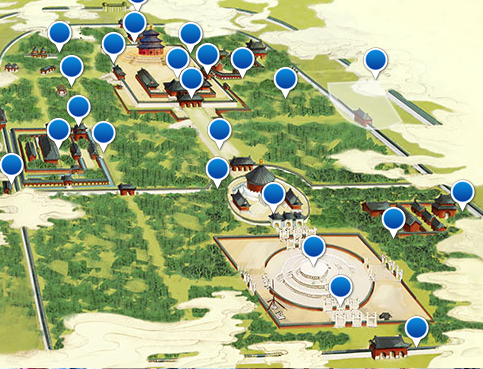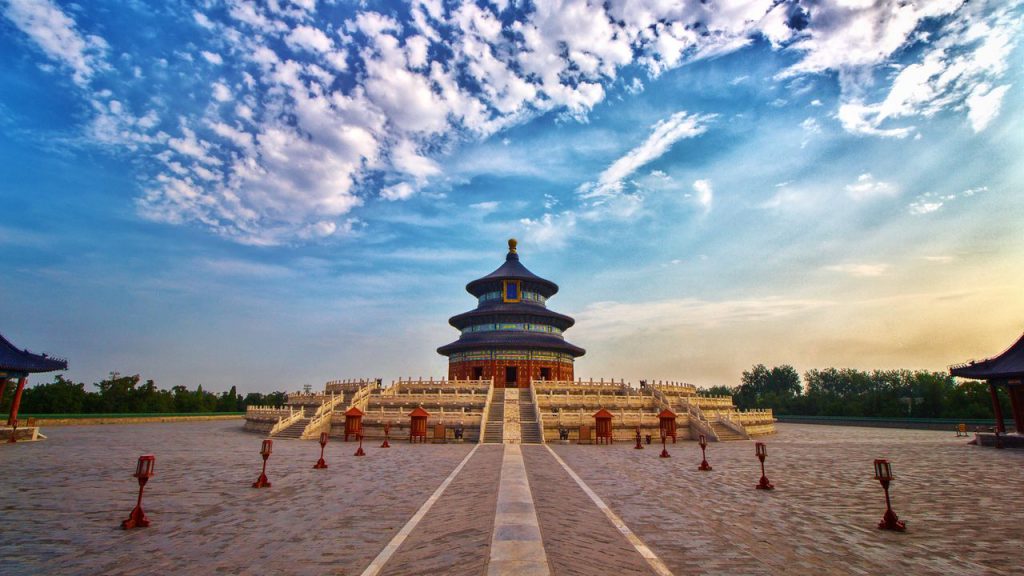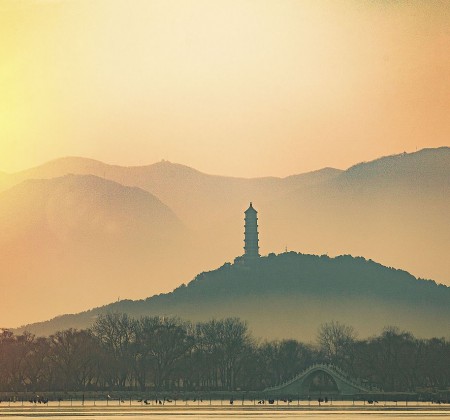The Temple of Heaven Park in Beijing
The Temple of Heaven is the place where the emperors of the Ming and Qing dynasties “offered sacrifices to heaven” and “prayed for grain”. It is located on the east side of Zhengyang Gate. The area is round in the north and square in the south, implying that “the sky is round and the earth is square”. Two altars are built around the walls, and the whole altar is divided into two parts, the inner altar and the outer altar, with a total area of 273 hectares, and the main buildings are concentrated in the inner altar.
The inner altar is divided into north and south parts by the wall. The north is the “Grain Prayer”, which is used to pray for the harvest in spring, and the central building is the Hall of Prayer for good harvests. The south is the “circular mound altar”, which is specially used for “the Winter Solstice” to offer sacrifices to Heaven. The central building is a huge round stone platform, named “Yuanqiu”. The two altars are connected by the Danbi Bridge, a 360m long corridor above the ground, to form a north-south axis of the Temple of Heaven with a large area of ancient Berlin on both sides.

There is a “Lent Palace” on the south side of the West Heavenly Gate, which is the place where former emperors fast. There is a “Shenyue Department” in the western outer altar, which is in charge of the teaching and performance of sacrificial music and dance. The main buildings in the altar are prayer hall, imperial dry hall, Qiqiu, imperial dome, Zhai palace, beamless hall, promenade, double-ring longevity pavilion, etc., as well as places of interest such as echo wall, three-tone stone, seven-star stone and so on.
The Temple of Heaven was built in the 18th year of Yongle in the Ming Dynasty (1420), and was added and rebuilt in the Ming Jiajing and Qianlong dynasties. The building is magnificent and the environment is solemn and solemn. After the founding of New China, the state invested a lot of money in the protection and maintenance of the cultural relics and monuments of the Temple of Heaven. The Temple of Heaven, which has gone through the vicissitudes of life, has become a portrayal of the ancient oriental civilization because of its profound cultural connotation and magnificent architectural style.
The Temple of Heaven is a treasure of Chinese ancient architecture and the largest architectural complex of offering sacrifices to heaven in the world. In 1961, the State Council announced the Temple of Heaven as a “national key cultural relic protection unit”. It was recognized as a “World Cultural Heritage” by the United Nations Educational, Scientific and Cultural Organization in 1998.
Historical Evolution of Temple of Heaven in Beijing
According to historical records, there are formal activities of offering sacrifices to heaven and earth, which can be traced back to 2000 BC, the Xia Dynasty, which was still in a slave society. The emperors of ancient China called themselves “sons of Heaven”. They respected heaven and earth very much. The Temple of Heaven was built in the shape of Nanjing in the 18th year of Yongle in the Ming Dynasty (1420) to offer sacrifices to the queen of heaven and earth. In the ninth year of Jiajing (1530), Emperor Jiajing decided to sacrifice heaven and earth separately, built a circular mound to offer sacrifices to heaven in the south of the Great sacrificial Hall, and built another Fangze altar outside the Anding Gate in Beicheng. In the thirteenth year of Jiajing (1534), Qiu was renamed the Temple of Heaven and Fangze was renamed The Temple of Earth. After the great sacrificial hall was abandoned, it was changed to pray for the grain altar. In the seventeenth year of Jiajing (1538), the Qigu altar was abandoned, and another Dahang Hall was built on the altar in nineteen years and completed in 24 years. Qing Qianlong sixteen years (1751) renamed the Hall of Prayer. Since then, it has been renovated and expanded many times.
In 1900, the allied forces of the eight powers set up a headquarters in the Temple of Heaven and set up a cannon on the mound. Cultural relics and sacrificial vessels were robbed, and buildings and trees were destroyed. After the founding of the people’s Republic of China in 1949, the government invested a lot of money in the protection and maintenance of the cultural relics and monuments of the Temple of Heaven. Many renovations and large-scale greening have been carried out to make the ancient Temple of Heaven more magnificent. The park covers an area of 200 hectares, with a door on each side. There are more than 2500 cypress trees over two hundred years old in the park. There are also a lot of flowers planted in the garden.
In 1961, the State Council announced the Temple of Heaven as a “national key cultural relic protection unit”. It was recognized as a “World Cultural Heritage” by the United Nations Educational, Scientific and Cultural Organization in 1998. On May 8, 2007, the Temple of Heaven Park was officially approved by the National Tourism Administration as a national 5A-level tourist scenic spot.
Architectural characteristics of Temple of Heaven in Beijing

Temple of Heaven Park was a place where emperors of the Ming and Qing dynasties offered sacrifices to heaven and prayed for a bumper harvest every year. The Temple of Heaven is famous for its rigorous architectural layout, peculiar architectural structure and magnificent architectural decoration. It covers a total area of about 2.7 million square meters and is divided into inner altar and outer altar. The main buildings are in the inner altar, with Qiqiu altar and Imperial Dome in the south, and the Hall of Prayer for New year and the Hall of Emperor Qian in the north. Danbi Bridge, a corridor connecting the north and south, connects these two groups of buildings. The ancient cypress of the outer altar surrounds the inner altar, making the main building complex more solemn and magnificent. In the altar, there are echo walls, three-tone stones, dialogue stones and so on, which are skillfully constructed by the principles of acoustics, which fully show the developed level of ancient Chinese architectural technology. Temple of Heaven Park is the largest preserved altar complex in China.
The Temple of Heaven has two walls, forming inner and outer altars, both of which are round to the north and to the south. At the beginning, in order to show the image of heaven and earth on the wall, to symbolize the saying that “the sky is round and the earth is square”. There are no doors on the north-east and north-south sides of the outer altar wall, but there are two doors on the inner street of Yongding Gate in the west: the north gate is old in the Ming Dynasty, which is called “the gate of praying for grain”; the south gate was built in the seventeenth year of Emperor Qianlong (1752), which is called “Yuanqiu altar gate”. The two doors are three arch coupons, green glazed simple tile Xieshan top. At present, the north gate and east gate of Waitan were built after 1975. There is also an east-west partition in the middle of the inner altar, which is counted as the north wall of the circular mound altar. This section of the partition wall protrudes northward in an arc on the two axes, bypassing the outer wall of the imperial dome and connecting with the inner altar wall of the east and west, dividing the two altars of Qigu and Qiqiu into two areas.
The mound of the inner altar is located in the south and Qigu in the north, all on the north-south axis, and the middle is connected by the Shinto (Danbi Bridge), which is 360 meters long and 30 meters wide. The main buildings in the Yuanqiu altar are Kuiqiu platform (sacrificial rooftop), Imperial Dome (shrine, Divine Kitchen and Divine Kitchen, Zaizhu Pavilion), etc.; in the Grain Prayer, there are prayer doors, Great sacrificial Hall (Hall of New year Prayer), East-West Hall, Emperor dry Hall, promenade (with seven-star stone), Divine Kitchen and Kitchen, slaughtering Pavilion, and so on.
The Temple of Heaven is the general name of the two altars of Qigu and Qiqiu, which is surrounded by two altar walls. The altar domain is divided into two parts: the inner altar and the outer altar, both of which are from the south to the north. The sacrificial buildings in the altar are concentrated on the inner altar, which is surrounded by doors. The axis connecting the two altars is a brick and stone platform 360 meters long, 28 meters wide and 2.5 meters high, known as “Shinto”, also known as “Haiyi Avenue”, also known as “Danbi Bridge”. It means that it will take a long way to go to heaven. The circular mound building complex, located at the southern end of the central axis, is the altar for the emperors of the Ming and Qing dynasties to offer sacrifices to the gods of heaven. To the north of the circular mound is the imperial dome. The grain prayer altar is located at the north end of the central axis, and the main building is the prayer hall, including the prayer door, the imperial dry hall, the east-west hall, the burnt firewood stove, the Kan, the brick door and so on. There are 72 attached buildings, such as the Divine Kitchen, the Zaizhu Pavilion and so on. The ancillary buildings of Yuanqiu Temple and Qigu Temple are mostly in the east, and this layout broadens the domain of the altar in the west of the Temple of Heaven. To the south of the West Heavenly Gate of the Inner Temple, there is a palace surrounded by Hao, named “Zhai Palace”, which is the palace where the emperor lived during the period of “fasting” before the sacrifice.
Knowledge of wild history
On the surface, the Temple of Heaven was the most solemn place in the Ming and Qing dynasties, but because of chaos at the end of feudalism and superficial stability, the order was already chaotic and miasma:
The Temple of Heaven in the Ming Dynasty can shoot arrows on horseback and buy tickets: according to the Wanliye compiled by Shen Defu in the Ming Dynasty, “only the Temple of Heaven has the most visitors.” Every year during the Dragon Boat Festival, these “tourists” hold horse-riding and willow-shooting competitions here, and many eunuchs also participate in it.
How dare you trample on the royal place of offering sacrifices to heaven? Because there is a Shenyue Department in the Temple of Heaven, which is responsible for soundtrack during the grand festival, and usually teaches apprentices, which is equivalent to the Royal Conservatory of Music, and works in the Temple of Heaven. In order to increase income, they first open tea sheds inside the altar, gradually use the Temple of Heaven as a park, and collect tickets.
In the early Ming Dynasty, the sacrifice of heaven and earth was carried out continuously, and the activities of the Temple of Heaven continued for many years. During the reign of Jiajing in the Ming Dynasty, the Great Rites of Ming Shizong was changed to separate sacrifices in the four suburbs, and The Temple of Earth, Sun Temple and Moon Temple were built. The status of the Temple of Heaven declined relatively, and the sacrificial activities became less frequent. Later, Ming Shizong was almost strangled to death in the Imperial Palace and moved to Xiyuan. He did not participate in the sacrifice for many years, and the Temple of Heaven sacrifice only sent officials to replace it. The management is getting careless.
During the Jiaqing period, there were not only many pharmacies in the ShenLok Department, but also a thriving trade in teahouses, “gathering a large number of people.” Emperor Jiaqing repeatedly ordered the Temple of Heaven to be cleansed, but only a few pharmacies were left.
If we strengthen the management, the emperor will cover everything, and there will be no time to consider the major issues of the national economy and the people’s livelihood. The management system of the Temple of Heaven in the Qing Dynasty was very strict, and the punishment for violators was also very strict. On the surface, the power was very powerful, but this trivial matter could not be managed well.
World Heritage Site
In 1998, the UNESCO World Heritage Committee added the Temple of Heaven to the World Heritage list.
The World Heritage Committee commented on the Temple of Heaven: the Temple of Heaven was built in the first half of the 15th century, located in the royal garden, surrounded by ancient pines, is a well-preserved temple complex, no matter in the overall layout or a single building, all reflect the relationship between heaven and earth, and this relationship occupies a core position in the ancient Chinese cosmology. At the same time, these buildings also reflect the unique role of emperors and generals in this relationship.
Reasons for inclusion on the World Heritage list:
(1) the Temple of Heaven is one of the accumulation of Chinese civilization.
From location selection, planning, architectural design, sacrificial etiquette and sacrificial music and dance, the Temple of Heaven is based on the theories of Yin and Yang and the five elements in the Book of changes in ancient China. The ancients’ understanding of “heaven”, “the relationship between heaven and man” and the desire for heaven were expressed incisively and vividly. All dynasties built altars to offer sacrifices to heaven, but the Temple of Heaven in Beijing is the only one that has been completely preserved, which is a masterpiece of the ancients.
(2) the Temple of Heaven architecture displays the unique moral and symbolic artistic expression of ancient China everywhere.
The scale and the number of components of the mound are concentrated and the number “nine” is repeatedly used to symbolize “heaven” and emphasize the connection with “heaven”. The Temple of Heaven symbolizes the sky with a circle and blue, and the pillars and rooms in the temple symbolize the four seasons of the year, 24 solar terms, twelve months and twelve hours of the day (in ancient times, twelve hours a day, every hour equals two hours), as well as the stars, which symbolize the sky.
(3) the Temple of Heaven is a masterpiece of ancient philosophy, history, mathematics, mechanics, aesthetics and ecology.
Temple of Heaven is a collection of architectural technology and art in the architectural design and construction of the Temple of Heaven. The Hall of Prayer for New year and the Imperial Dome are wooden components, round plane, huge shape, refined craftsmanship and ingenious conception, which are rare examples in Chinese ancient architecture. The Temple of Heaven has created the ecological environment of “Heaven and Man Harmony” with a large area of forest and rich vegetation. it is a kind of object for the study of ancient architectural art and ecological environment, which is of great scientific value, and is an outstanding example in the royal altar building complex.
The composition center prayer hall in the north of the building axis is majestic, the structure is exquisite, the internal space rises to the center, and the outer foundation eaves shrink and lift layer by layer, which not only causes a strong sense of upward movement, but also makes people feel dignified and stable. The color contrast is strong without losing the coordination and propriety. Make people step into the altar like auspicious clouds to the heavenly world. The Temple of Heaven, from overall to partial, is an excellent work of ancient architecture, a masterpiece of craftsmanship, of great artistic value, and a relic and carrier of ideology and culture in a long historical period of the Chinese nation. Temple of Heaven is a materialized ancient philosophy, which not only has high historical value, scientific value and unique artistic value, but also has profound cultural connotation.
To sum up, the Temple of Heaven, an ancient altar building group, has high historical value, scientific value and unique artistic value, as well as profound cultural connotations. with the criteria for inclusion in the World Cultural Heritage list: the Temple of Heaven, a masterpiece of art with worldwide outstanding value, will be more beneficial to its protection and make it handed down forever.
Opening hours of scenic spots
- Peak season: (April 1 of each year to October 31 of that year).
- Off-season: (1 November of each year to 31 March of the following year).
The gate of the park:
- Peak season opening hours: 6:00 to 21:00.
- Off-season opening hours: 6:30 to 21:00.
- Quiet garden time: 22:00.
Scenic spot ticket price
Peak season: (April 1 of each year to October 31 of that year).
- Ticket: 15 yuan, concessionary ticket: 7.5 yuan.
- Joint ticket: 34 yuan, concessionary ticket: 17 yuan.
Off-season: (1 November of each year to 31 March of the following year).
- Ticket: 10 yuan, concessionary ticket: 5 yuan.
- Joint ticket: 28 yuan, concessionary ticket: 14 yuan.
Traffic routes
East Gate: take No. 6, 34, 35, 36, 39, 43, 60, 116, 128, 525, 623, 684 and get off at Tiantan Dongmen Station, Metro No. 5 Tiantan Dongmen Station, exit A.
South Gate: take 36, 53, 122, 525, 958, Special 11, Special 12, 20 Night, Express 102 get off at the Temple of Heaven South Gate Station.
North Gate: take Road 6, 34, 35, 36, 72, 106, 110, Night 11 and get off at the Temple of Heaven Beimen Station.
West Gate: take Road 2, 20, 36, 53, 120, Night 2, Night 17 and get off at the West Gate of the Temple of Heaven.











